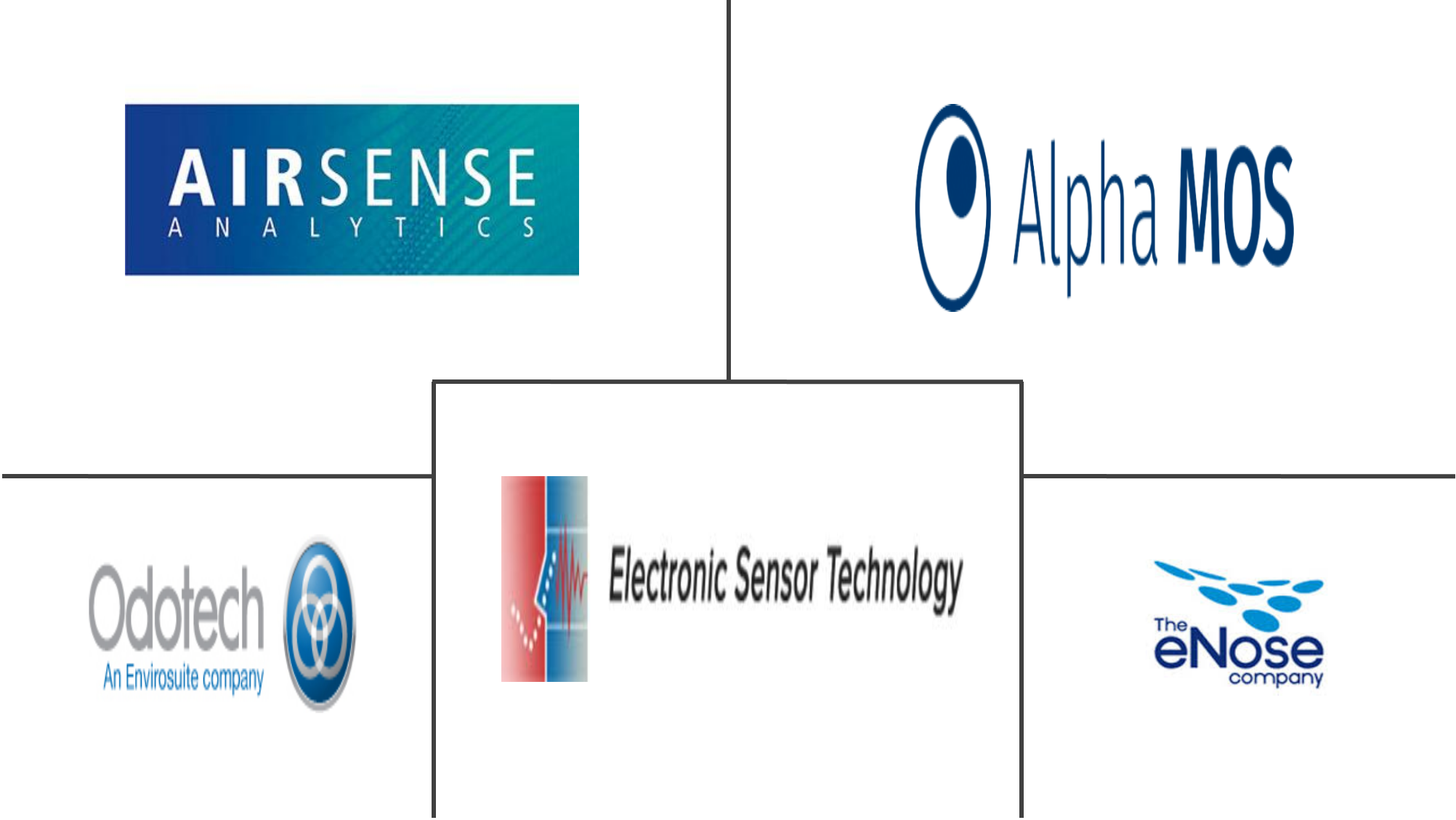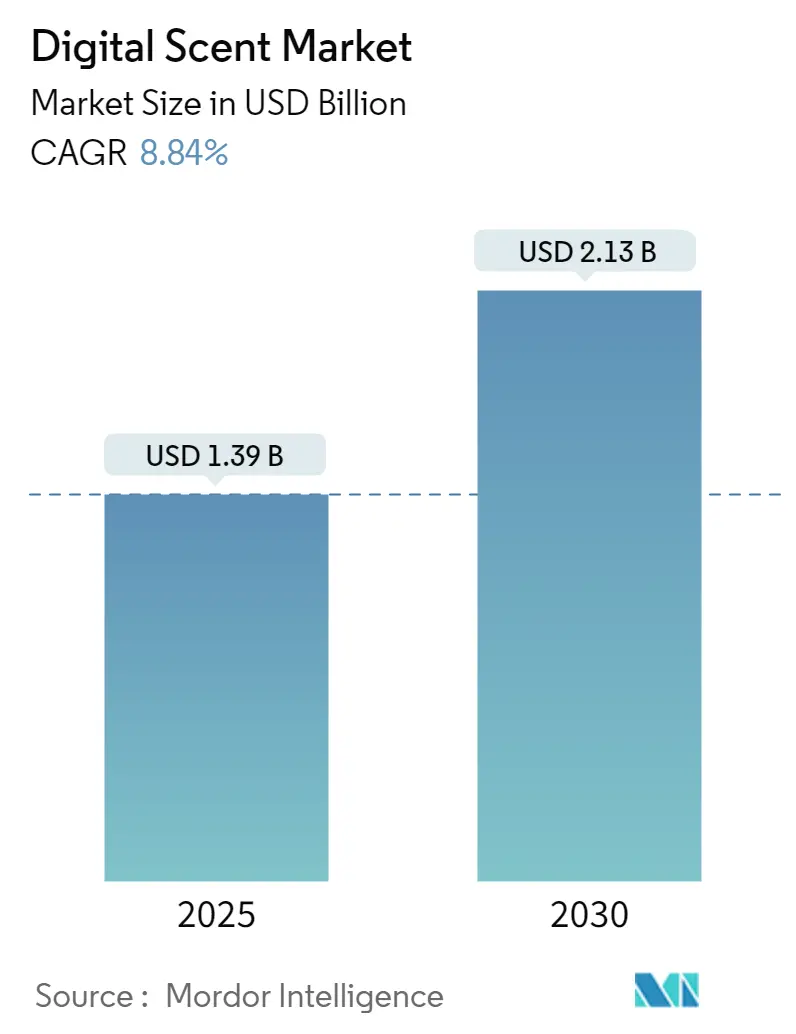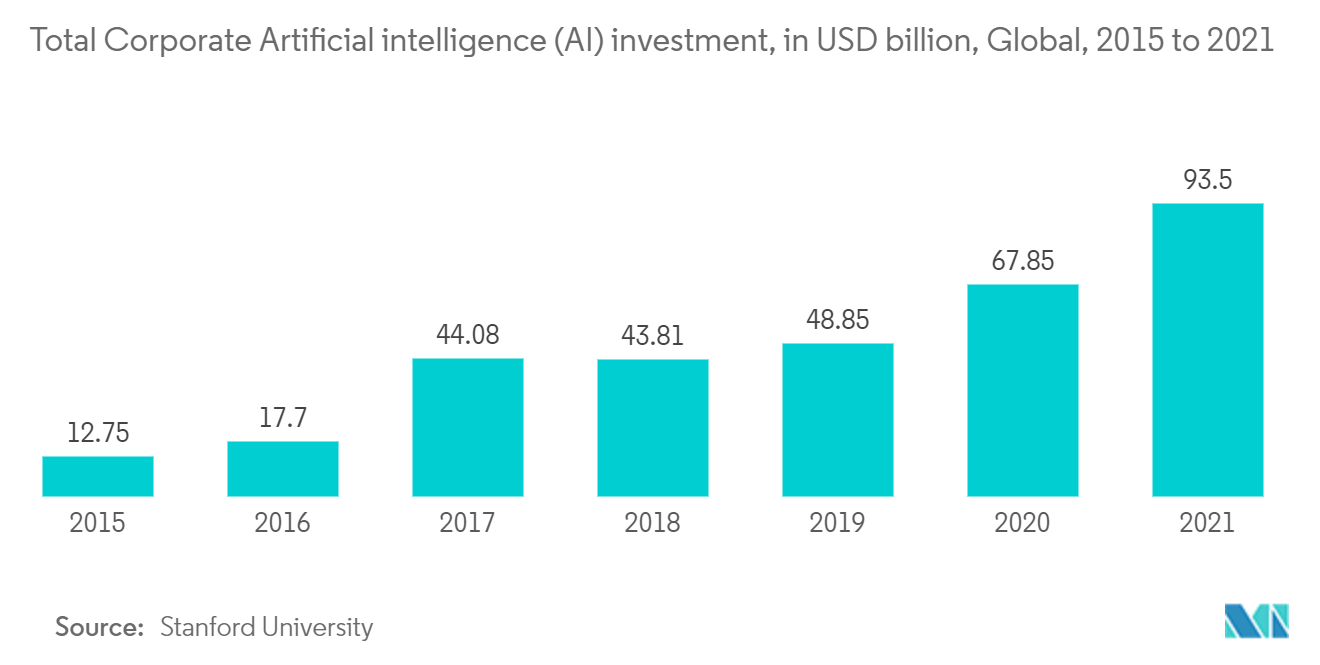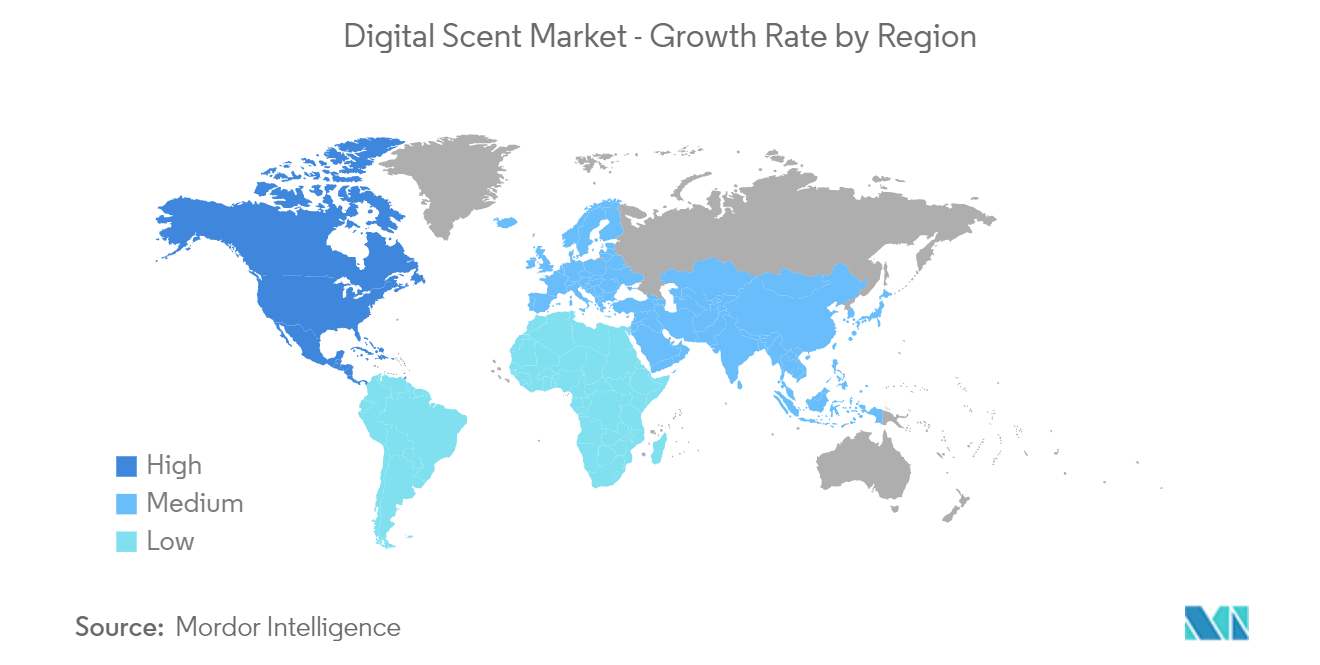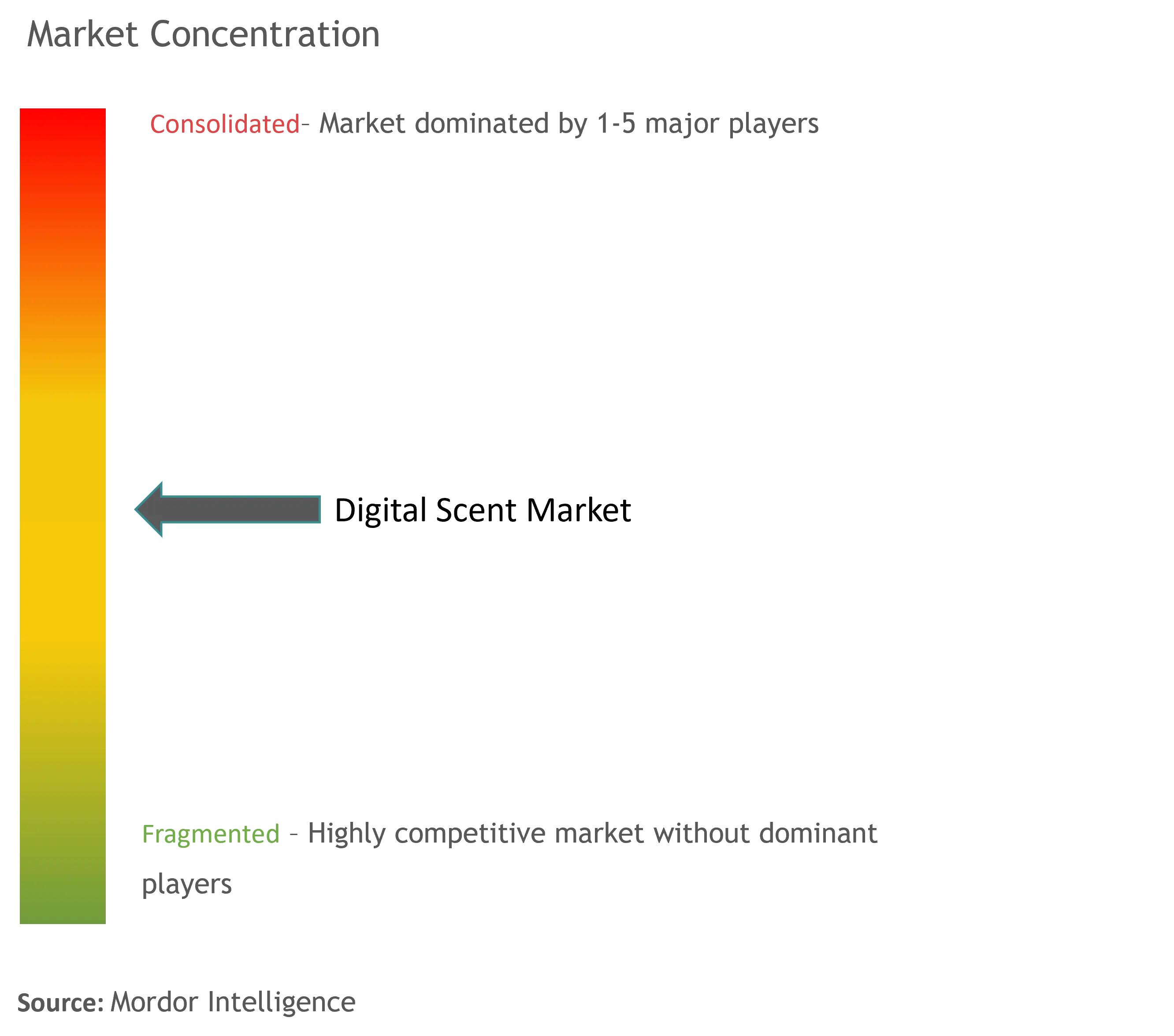Digital Scent Market Analysis
The Digital Scent Market size is estimated at USD 1.39 billion in 2025, and is expected to reach USD 2.13 billion by 2030, at a CAGR of 8.84% during the forecast period (2025-2030).
The Digital Scent Technology Market is expected to increase steadily over the forecast period, owing mostly to technological advances for establishing a sense of scent in online communication. Currently, three senses are involved in internet communication: hearing, touching, and sight. One of the notions of virtual reality is the digital smell. In general, the digital smell is a combination of hardware and software technology.
- In the quality assurance division of the fragrance industry, digital scent technology has been used more and more. Further, to streamline the labor-intensive and time-consuming quality control process, the expanding global fragrance business is investing more and more in digital scent technology and focusing on meeting the market's highest criteria, the top fragrance industries. Digital olfactory sensors can monitor changes in perfume after exposure to specific skin types or environmental factors. The market for digital scent technology has expanded due to these appealing features of digital noses.
- In many applications, including those involving perfumes, food and beverages, and other technologies, digital scent technology is highly dependent on human ability. Even police dogs have limited ability to detect and distinguish between distinct odors. The information took time to quantify and process as a result. However, businesses like IBM and E-Nose Systems have successfully used AI to process further and categorize the scents. With AI, it is now possible to gain more sensitivity and expand the system's capabilities. IBM's algorithm has simplified the labor-intensive manufacturing procedure needed to make lab-made fragrances and odorants.
- According to the International Telecommunication Union, 51% of the global population uses mobile-cellular devices, with around 4 billion having internet access. Researchers have been expanding the installation of Digital Scent Technology in-built into smartphones due to the widespread availability of smartphones with internet connectivity worldwide. In recent years, the industry has seen the introduction of Digital Smell. Researchers hope to create virtual-reality long-distance discussions. This will give users a true sensation of sight, speech, and smell. These advancements will significantly impact the global Digital Scent Technology Market. Major market players have already invested in research and development to build these smartphone systems.
- In order to effectively combat the pandemic, it is crucial to have the ability to swiftly and affordably screen people for COVID-19. NASA is using its expertise to aid with this effort. The Department of Health and Human Services has provided NASA with USD 3.8 million to improve the E-Nose device created at NASA's Ames Research Center in California's Silicon Valley using patented nanosensors and nanosensor array technology for COVID-19 detection. NASA is developing E-Nose, a smartphone-based gadget, to detect COVID-19 by "sniffing" a person's breath. It is based on technology previously used to help monitor air quality inside spacecraft.
- The digitalized smell sensor technology of the E-noses and the scent synthesizer technologies must be improved by reliable airflow. These elements have decreased the E-noses' product value. These technologies are heavily used in enclosed spaces where the airflow is controlled, and other environmental odors don't interfere with one another. These limitations have limited the industry's use of E-noses and other technologies. Identifying and measuring the odor in the little concentration is the main challenge. There is a larger likelihood of significant signal interference when an odor is present in low concentrations.
Digital Scent Market Trends
Introduction of AI in Digital Scent Technology
- The human nose employs odor molecules emitted by inorganic and organic things to enable the sense of smell. When the energy in things increases, the odor evaporates, allowing them to be inhaled and absorbed through the nasal cavity. Digital olfaction functions similarly. It first gathers odor signatures with biosensors, analyzes the odor data, and displays the results with software solutions. Artificial intelligence helps interpret the signatures and classify them based on a database of previously collected smells.
- According to National Security Commission on Artificial Intelligence, In its final report, it proposed Congress increase federal R&D funding for AI by a factor of two annually, up to a total of USD32 billion in fiscal 2026. The federal R&D budget will be increased by 28% from FY 2021 authorized levels to more than USD 204 billion under the Biden administration's fiscal of this year budget plan. The National AI Research Institutes, both new and established, would get some of that funds. Such investments are expected to drive the demand for incorporating AI in digital scent technology.
- Further, according to Stanford University, global total business investment in artificial intelligence (AI) will reach almost USD 94 billion in 2021, a considerable rise from the previous year. The annual investment in AI showed a modest decrease in 2018. However, this was only temporary. The majority of overall AI business investment is made up of private investments.
- In September last year, Google AI used artificial intelligence to create a map correlating odors to chemical structures. It is as accurate as a human in describing a substance's stench, and the researchers behind the experiment think it is an important step toward digitizing scents. A fundamental difficulty in olfaction is mapping molecular structure to odor perception. The Google AI researchers create a Principal Odor Map (POM) that preserves perceptual associations and enables odor quality prediction for novel odorants using neural graph networks (GNN).
- Similarly, a team of scientists led by Nanyang Technological University, Singapore (NTU Singapore) has developed an artificial scent system that reliably assesses the freshness of meat by mimicking the mammalian nose. The 'electronic nose' (e-nose) consists of a 'barcode' that changes color over time in response to the gases released by meat as it decays and a barcode reader in the form of an artificial intelligence-powered smartphone app. The e-nose has been trained to recognize and predict meat freshness from a wide library of barcode colors.
North America is Expected to Hold Major Share
- North America is expected to gain traction in the global digital scent market during the projected period. Top North American manufacturers such as RoboScientific, ALPHA MOS, and others are aiming to reduce the size of electronic noses through research and development (R&D) operations to boost their client base and gain a competitive advantage. The goal is to create a portable, cost-effective, and tiny electronic nose that can produce accurate results and suit market demands. This is fueling the expansion of North America's worldwide electronic nose market.
- The increase in healthcare spending is likely to drive the market. According to the Centers for Medicare and Medicaid Services, U.S. healthcare spending would increase by 2.7% in 2021, reaching USD 4.3 trillion, or USD 12,914 per person. Health spending accounted for 18.3%of the nation's GDP. Further, it is also possible to use eNose to diagnose various disorders. It has long been recognized that certain diseases affect internal organs or metabolism and alter the composition of exhaled air. Diabetes patients, for example, expel comparatively large amounts of volatile chemical compounds such as acetone. The eNose, which comes with an easy-to-use smell sensor, could be used to determine blood sugar levels and monitor diabetes settings.
- One of the driving factors for market expansion is the growing health concern. Thus, demand for digital scents is predicted to rise for usage in the food and beverage (F&B) business to improve food quality, which in turn aids in the reduction of diseases caused by food contamination. According to the Centers for Disease Control and Prevention (CDC), 48 million people get sick from food-borne infections yearly, with 3,000 dying. This electronic nose comprises sensors that can detect the presence or absence of toxins and associated chemicals. As a result, this electronic nose is employed throughout the food manufacturing process to ensure food quality.
- The explosive detectors segment in the North America region is expected to develop during the forecast period due to its extensive application in military and defense. The growing number of terrorist bombings has produced a significant demand for technologies that can detect explosives accurately and swiftly to limit damage. The military and police employ explosive detectors to identify explosives in combat zones and public locations in order to protect citizens.
- The recent applications of digital scent technologies have come through advancements in sensor design, material improvements, software innovations, and progress in microcircuitry design and systems integration. The developing infrastructure in the region, coupled with the rising adoption of technological advancements across various industries to better the business model, is set to boost the growth of the overall digital scent market.
Digital Scent Industry Overview
The digital scent market is both cohesive and cohesive. Ongoing research and technological advancements are expected to be the key trends in the market. The companies are adopting various strategies to expand their customer base and mark their presence in the market. Some key players are Alpha MOS SA, Electronic Sensor Technology Inc., Plasmion GmbH, Odotech Inc., The eNose Company, and AIRSENSE Analytics GmbH, among others.
- May 2022: Cardea Bio, Inc., the mass producer of biocompatible semiconductors, announced that the Bill & Melinda Gates Foundation had awarded it a USD 1.1 million grant to develop a BPU (Biosignal Processing Unit) assay with high sensitivity and specificity that incorporates receptors capable of detecting volatile compounds to diagnose infectious diseases in developing countries rapidly. This study aims to see if Cardea BPUs functionalized with an insect Odorant Receptor [iOR] can detect an agonist odorant.
- June 2022: Firmenich has announced a strategic alliance with ScentRealm, a pioneer in digital scent technology based in Hangzhou, China. This relationship is the first of its type in China, bringing together the expertise of a fragrance business and a sense experience explorer. It will allow Firmenich to improve the fragrance and olfactory experience for its clients and consumers by utilizing developed digital devices and investigating the digital future of scent. Firmenich is at the forefront of digital transformation, having introduced the industry's first AI-augmented laundry care fragrances and the first flavor created by AI by merging AI technology with human creativity.
Digital Scent Market Leaders
-
Airsense Analytics GmbH
-
Alpha MOS SA
-
Odotech Inc.
-
The eNose Company
-
Electronic Sensor Technology
- *Disclaimer: Major Players sorted in no particular order
Digital Scent Market News
- April 2022: The EU-funded project "Smart Electronic Olfaction for Body Odor Diagnostics" - SMELLODI for short - started with a meeting. The seven partners aim to create intelligent electronic sensor systems that can discriminate between normal body scents and those affected by sickness and convey them digitally. The partners are from Germany, Israel, Finland, and Germany. The technology created over three years with roughly EUR 3 million in funding is intended to pave the way for the digitization of smell.
- January 2022: Inhalio introduced its Digital Scent 3.0 Platform, a technology platform used to develop Inhalio scent cartridges for vehicles and homes. The technological platform employs a data-centric process for infusion and diffusion technologies, app support, and cloud control. V-313485 Air Sanitizer fragrance cartridges for airborne viruses, Malodor scent cartridges for airborne odors, Motion Sickness Relief scent cartridges for motion sickness, and Mood Mapped Scent cartridges for focused driving are presently available from Inhalio.
Digital Scent Industry Segmentation
Digital scent technology is a technology which helps to sense, transmit, and receive scent-enabled digital media such as web pages, movies & music. The technology uses hardware devices consisting of gas sensors such as e-nose and scent synthesizer, which help in sensing and generating different types of smells. It mainly refers to online communication using the human nose. This technology is a critical application for e-nose as it enables the transmission of odor over the internet. This innovative technology works with the help of olfactometers and electronic noses.
The Digital Scent Market is segmented by Hardware (Scent Synthesizer, E-Nose), End-user Industry (Healthcare, Military & Defense, Food & Beverage, Entertainment, Communication), and Geography (North America, Europe, Asia Pacific, Rest of the World).
The market sizes and forecasts are provided in terms of value (USD million) for all the above segments.
| By Hardware | Scent Synthesizer |
| E-Nose | |
| By End-user Industry | Military and Defense |
| Healthcare | |
| Food and Beverage | |
| Waste Management (Environmental Monitoring) | |
| Other End-user Industries | |
| Geography | North America |
| Europe | |
| Asia Pacific | |
| Rest of the World |
Digital Scent Market Research FAQs
How big is the Digital Scent Market?
The Digital Scent Market size is expected to reach USD 1.39 billion in 2025 and grow at a CAGR of 8.84% to reach USD 2.13 billion by 2030.
What is the current Digital Scent Market size?
In 2025, the Digital Scent Market size is expected to reach USD 1.39 billion.
Who are the key players in Digital Scent Market?
Airsense Analytics GmbH, Alpha MOS SA, Odotech Inc., The eNose Company and Electronic Sensor Technology are the major companies operating in the Digital Scent Market.
Which is the fastest growing region in Digital Scent Market?
North America is estimated to grow at the highest CAGR over the forecast period (2025-2030).
Which region has the biggest share in Digital Scent Market?
In 2025, the North America accounts for the largest market share in Digital Scent Market.
What years does this Digital Scent Market cover, and what was the market size in 2024?
In 2024, the Digital Scent Market size was estimated at USD 1.27 billion. The report covers the Digital Scent Market historical market size for years: 2019, 2020, 2021, 2022, 2023 and 2024. The report also forecasts the Digital Scent Market size for years: 2025, 2026, 2027, 2028, 2029 and 2030.
Our Best Selling Reports
Digital Scent Industry Report
Statistics for the 2025 Digital Scent market share, size and revenue growth rate, created by Mordor Intelligence™ Industry Reports. Digital Scent analysis includes a market forecast outlook for 2025 to 2030 and historical overview. Get a sample of this industry analysis as a free report PDF download.

